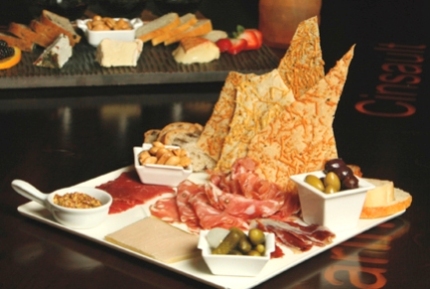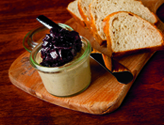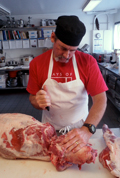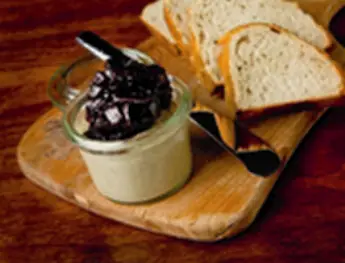 “Charcuterie takes time, knowledge, and temperature. Not all of us have that, but the end product you taste after working on and watching over it is oh so good!” says Chef de Cuisine Marissa Gerlach of Raya at The Ritz-Carlton, Laguna Niguel.
“Charcuterie takes time, knowledge, and temperature. Not all of us have that, but the end product you taste after working on and watching over it is oh so good!” says Chef de Cuisine Marissa Gerlach of Raya at The Ritz-Carlton, Laguna Niguel.
Chef Gerlach is one of a growing number of chefs making their own preserved meats and sausages. As in other house-made from scratch items, quality ingredients and twists on flavor are sought.
“It has always been a passion of mine to be in touch with our product as much as possible which translates into making it ourselves,” says Chef de Cuisine Matt Roman of Haven Gastropub in Orange.
“I’ve always loved eating charcuterie and as I did I would start to think about infusing other unique flavors into it,” says Gerlach.
Love also compelled The Tasting Kitchen’s Executive Chef Casey Lane to master charcuterie as well as, “the mystery of how.” The chef of the popular Venice restaurant purchased his own equipment, studied, and practiced on his days off at home. He’s enjoying, “getting to the point to where your product is actually better than what you can purchase.”
Types of charcuterie
Sausage and cured meats are traditional techniques developed for two main purposes: to preserve meat in the days before refrigeration and to avoid waste by using every part of the animal. The processes include grinding, curing, drying, smoking, cooking, and salting.
As defined in Fritz Sonnenschmidt’s how-to book, Charcuterie, sausage is made from ground meat and can be raw (bratwurst or bulk), cooked (liverwurst or blood sausage), poached (cold cuts), or cured and air-dried (salami). The meat is seasoned and formed in a casing.
Charcuterie encompasses sausage, pate, terrines, and smoked or cured meats made with whole muscle meats such as ham and bacon.
“The longer the prosciutto ages, the more intense the flavor and the more the buttery, silky texture develops,” says Bryan Liem, Kitchen Coordinator at The Bruery in Placentia. Proscuitto, dry-cured ham and speck, a smoked prosciutto, are on the platter. Meats and cheeses are served in The Bruery’s tasting room to sample with their selection of unfiltered, unpasteurized beers.
The ambitious Chef Paul Buchanan, a Long Beach caterer, makes his own charcuterie starting with a whole pig sourced locally. He has made finocchiona (Tuscan salami made with fennel seeds, ground pork, aged up to a year), Oaxacan mole salumi (cured pork and mole spices), coppa (pork shoulder, marinated and air-dried), peparone (pepperoni), smoked hams, bacon and a variety of fresh sausage. “I have used elk and duck and will look into making breasola from beef soon,” says Buchanan.
TAPS Fish House & Brewery in Brea and Proprietor Joe Manzella invested in an Italian prosciutto slicer to best present San Danielle (Italy) prosciutto (dry-cured ham usually served sliced thin and uncooked), La Quercia (Iowa, boldly flavored with Spanish paprika and cumin), coppa picante (herbal, smoky, spicy pork shoulder), and Berkshire Lonza (delicate, herbal, soft, meaty pork loin), Creminelli Bresaola Piccolla (eye of round beef), sopressa (pork, lard, garlic), and Calabrese Salami (aka pepperoni).
TAPS sourced the above-mentioned products carefully for their new charcuterie and cheese board to complement the brewery’s award-winning beers. “We had no less than five tastings with our purveyors. On the lonza, “Chef Tom (TAPS Director of Culinary Tom Hope) wanted an additional meat that wasn’t a salumi or a ham. We tasted the lonza and loved it. It’s a domestic product from Iowa that is painstakingly prepared by a husband and wife team that learned their craft in Italy.” The Creminelli? “Cristiano Creminelli came to America to make salumi and found the ideal climatein, of all places, Utah.”
Manzella, Hope, and Brewmaster Victor Novak have some specific beer pairing recommendations, “The Irish Red goes fantastically well with the coppa piccante, and the prosciutto pairs nicely with our cream ale or hefeweizen.”
Favorites
“Salumi is a living, ever-changing product,” says Buchanan who favors coppa but finds fermented sausages, cured and aged, the most challenging and rewarding. He enjoys others’ efforts also. “I like the Classic Molinari Italian Sausage produced in San Francisco and the Salumi by Armadillo Batalli is outstanding. If someone is coming back from Italy, I ask them to bring back Spinata Romana for me. I want to make a salumi like that.”
 Chef Gerlach is fond of her smoked foie mousse (see photo). “It’s so easy to make that it’s hard to even call it charcuterie.”
Chef Gerlach is fond of her smoked foie mousse (see photo). “It’s so easy to make that it’s hard to even call it charcuterie.”
When purchasing meats, Gerlach finds imported brands better than most American ones. “Making cured, dry aged charcuterie the right way breaks a lot of rules in US serve-safe’ standards. That is why we will never have products that taste the way they do overseas. Taste test and see for yourself.”
“I’ve had most success with a Tuscan fennel sausage with minced garlic and peppercorns,” Roman says. He takes great pleasure in making his own and finds new appreciation of the work of others. “You tap into an ancient practice that has survived centuries.”
Mortadella is a favorite for Chef Lane and just one of many he’s made; Luciana a very old Italian sausage recipe, spicy Italian, chorizo both dry cured and fresh, soppressata, and lonza are just a few.
Coming soon in Orange is a place devoted to sausages. LinX will feature sausage, frites and craft brews. “Nirvana!” exclaims Chef/Operator Scott Brandon. “I’m able to work with artisans who are passionate about what they do.”
Brandon is purchasing signature sausage such as frankfurters, Neurenberger bratwurst, knackwurst, bockwurst, spicy Polish, and Sicilian created just for LinX by nearby Europa Specialty Sausage. “We will also be making unique special sausages for our secret menu, think buffalo chicken, 24-inch frankfurter and Louisiana boudin.”
Brandon has made his own sausage but is happy to trust the experts at Europa. “Europa’s shop is less than two miles from LinX, so it fits right into our model of consciously, locally sourced ingredients, and minimizing our impact on the environment.”
Brandon will make condiments such as the 15 different sauces to accompany, “the best fries you’ve ever tasted crispy outside, creamy inside, and addictive.” Curry ketchup, bacon and blue cheese aioli, red ranch, chorizo mayo, and others add a wow factor to both the frites and the brats.
Paddy Glennon, the man behind Europa Specialty Sausage, learned charcuterie as stagiaire at butcher shops in Ireland, Spain,and France. “We do everything in small batches, no more than 200 pounds at a time. We strive for a good lean sausage, 72 percent lean, smoked with natural hard woods.”
These richly flavored, ever-tempting products are worth seeking out or making for yourself and your guests.
Tips from chefs making their own charcuterie
A class would be one way to start. Books are also helpful. “Start with a small recipe and do it by hand before buying too much equipment,” suggests Chef Buchanan.
“When it comes down to curing and dry-aging, you are better off working under someone for a year and overseeing the operation taking notes,” Gerlach recommends.
Practice, attention to detail, and some trial and error are required to master sausage making. Stuff happens. As Gerlach shares, “We must learn from mistakes.”
Experience is the best teacher. “You want salumi to dry enough but not too much. Some of my mole salumi dried to long and got crumbly (call me anytime for rejects). The changes in flavor come with time,” says Buchanan. “What I thought was too much salt, months later turned out to be just right. You worry about molds, time, temperature, and humidity.” Something earlier generations clearly worried less about since many meats were aged and smoked by hanging in the home chimney.
Roman admits to moldy pancetta, broken emulsions, and under seasoning: “All of them (goofs) you can possibly make.” He got some basics in culinary school and was hooked. “It’s easy enough to make fresh sausage and I have always done this for holidays at home, but to get into the more complex process of aging and curing was a different direction.” He buried his nose in books and tested recipes. He’s crafted sopressata (Italian dry salami), Spanish chorizo (cured, dried, smoked paprika), saucisson sec (cured, dried, pork or pork mixed with other meats), Tuscan salami, and a wild boar sausage currently on the menu at Haven.
“Follow the procedures you read precisely. When you are doing anything that is so delicate, up to the point that you have some familiarity with it, you cannot blend methods and expect good results,” says Lane.
Equipment and ingredients
Thinking about trying your own hand at charcuterie? Some equipment and space is  needed but our experts recommend starting simple and small. “A large fridge and freezer in the garage might be enough,” says Buchanan (see photo). Sausage grinder, sausage stuffer and a curing cabinet you can build yourself from a small refrigerator are other necessities.
needed but our experts recommend starting simple and small. “A large fridge and freezer in the garage might be enough,” says Buchanan (see photo). Sausage grinder, sausage stuffer and a curing cabinet you can build yourself from a small refrigerator are other necessities.
“A Kitchen Aid and the meat grinding attachment,” is an alternative offers Roman. “You’ll have pate molds, a digital scale and instant read thermometer. Most of which can be found at a Williams-Sonoma or Sur La Table,” he adds.
“Research what you need and don’t leave anything out. If a charcuterie calls for curing salt, it’s there for a reason,” Gerlach pronounces.
Chef Roman lists some special ingredients that may be called for: bactoferm, sodium nitrate and nitrite. “We had to find places that sold some of the more esoteric bacterias, yeasts, molds, and starter cultures. Butcher and Packer and sausagemaker.com are good places to start.”












